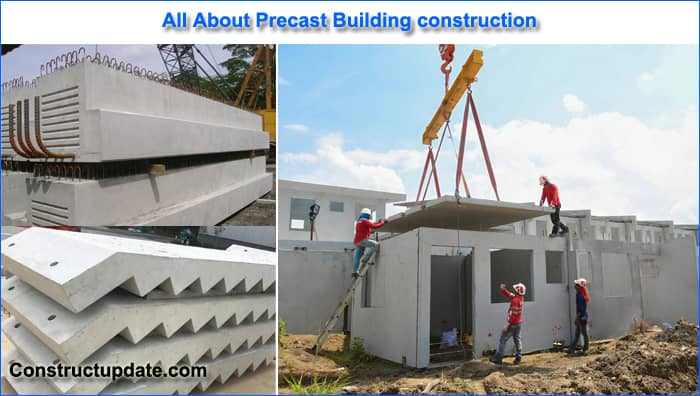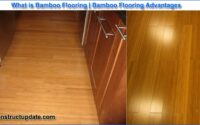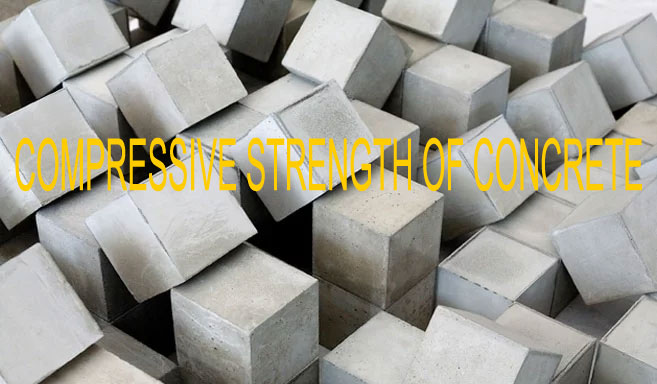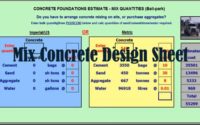Precast Building Construction | Components of Precast Concrete Construction | Advantages of Precast Construction
The precast concrete construction system has unique properties that have a significant impact on the design, span length, construction depth, and stability system. Most structural components used in precast concrete construction are produced at factories that are not part of the construction site. Afterwards they are transported to the project site where they will be put up.
Several connections, such as the connection between a beam and a column or a panel and a panel, have been devised to join various kinds of structural parts. In this way, the superstructure transfers the applied loads to the foundation. Prior to completing the design of a precast concrete structure, designers should take into account the options, constraints, detailing, manufacturer, transport, erection, and serviceability stages.
Types of Precast Systems
Several precast systems must be understood in order to comprehend the building of precast concrete structures.
Precast systems can be divided into four main categories according on the load-bearing structure:
1. Large Panel System
Apartment and hotel buildings can benefit from large panel systems. It is made out of concrete panels on the floor and enormous walls that are joined vertically and horizontally. Both vertical and horizontal panels can endure gravitational loads. The cross-wall system, longitudinal-wall system, and two-way system are the three large panel system configurations depending on wall layouts.
2. Block system
In order to construct walls or slabs, precast blocks with a rectangular or quadrangular prism shape include a normal-weight hydraulic concrete casing, lightweight concrete, or a comparable substance. The length of the wall or slab to be built is included in the steel-reinforced blocks used for walls, mezzanines, or rooftop slabs.
Blocks that are light enough to transport and physically install on-site are simultaneously provided by an acoustic, thermal-insulating lightweight material stored in the interior. The blocks are horizontally stacked one on top of the other with block or another glue between them to create walls. The blocks have tongues and grooves on the top and bottom surfaces. Blocks are alternately positioned to create armed headframes at the corners and “T” crossings for stability and resistance.
When using blocks for slabs, the tongue and groove system is installed on the sides, one next to the other, with block or another type of glue in between. Rods are positioned transversely across the slab to prevent temperature retraction.
3. Portal frames
The blocks are horizontally stacked one on top of the other with block or another glue between them to create walls. The blocks have tongues and grooves on the top and bottom surfaces. Blocks are alternately positioned to create armed headframes at the corners and “T” crossings for stability and resistance. When using blocks for slabs, the tongue and groove system is installed on the sides, one next to the other, with block or another type of glue in between. Rods are positioned transversely across the slab to prevent temperature retraction.
4. Multi-storey steel frame structure
The beams and columns of a multi-story steel frame construction are made of hot-rolled and welded H-shaped steel. The beam and column arrangement in these frames supports the gravity load, including dead and live loads. Nowadays, steel frame construction is mostly employed worldwide for residential, commercial, and institutional structures.
5. Wall system
Precast walls have a large thermal mass, which makes it possible for materials to absorb and retain temperatures at a more steady pace, making them energy-efficient. This system lessens the temperature fluctuations inside the structure. Precast wall panels have a low impact on the site because they are produced at a production facility. This lessens the amount of area required on a job site. Precast wall panels can be altered to suit the needs of the owner or architect. Bullnoses, reveals, chamfers, and a wide variety of form liners are some architectural features that can be found in a wall panel system.
6. Floor System
There is a huge demand for a strong, lightweight, and energy-efficient precast concrete floor structure that can be produced in a variety of sizes. Precast concrete planks are cast with continuous circular voids running through the panel’s length to aid minimise flooring weight for transportation, erection, and foundation loading. Prestressing strands are cast into the panels during manufacture to give them extra strength. Hollowcore is a very robust structural element that is used to span wide spaces between construction columns and walls thanks to its top and bottom longitudinal flanges.

Components of precast concrete construction
Prefabricated parts needed for the building structure are assembled and connected to create a precast building. They consist of;
1. Footings
Precast footings are foundations that are quick and easy to install and may be used straight immediately as they arrive on site. They offer a flat and secure foundation upon which to construct and are incredibly strong.
2. Beams
Today, precast concrete beams are a common component of many structures. They offer an affordable flooring option and are particularly well suited to floor construction in homes, apartments, and commercial structures. Along the perimeter of the building, sill-equipped edge and spandrel beams enhance strength while serving as the foundation for floor slating. Similar to spandrel beams, spine beams feature two sills. Precast concrete suspended beam and block floor solutions reduce the need for excavation.
3. Columns
Precast concrete columns offer strength and flexibility and lengthen the life of any structure since they are both strong and flexible. According to the architect’s plan, columns may include any special features or fittings. These columns are labor-saving since they may be built up to five times faster than in-situ concrete production techniques.
4. Shear Walls
Precast concrete wall panels can be used to cover both internal and outdoor surfaces. Together, they can provide a shear wall by providing strength and lateral stability. The most popular technique, which makes it possible to calculate lateral-force resistance, involves using wall panels and building them up. They have been used in structures up to 30 stories high, however, they are more typically found in lower-level buildings.
5. Partition Walls
To form a wall-to-ceiling partition wall, precast concrete panels can be cemented together on site or hoisted into place. Comparing this type of assembly to other brickwork, the speed difference can reach six times. Panels can be used in hotels, kitchens, hospitals, schools, and apartments since they are well-suited for sound insulation.
Uses of Precasting Concrete Construction
Due to its strength, longevity, and affordability, reinforced concrete is typically employed for structural structures. Using precast concrete involves the following:
- To create floor slabs, foundations, beams, columns, and other structural components for structures
- to create building cladding or wall panels
- to produce precast pre-stressed construction components (see below)
- to produce parts for infrastructure projects: Precast parts, such as bridge spans or metro line viaducts, are widely used in casting yards.
- to produce goods for sale: Precast products include water tanks, septic tanks, drainage chambers, floor beams, boundary walls, and water pipelines.
- It can be moulded into any shape, making it ideal for creating unique, odd objects like boats, sculptures, and the like.
Precast Construction Advantages
Precasting is effective for producing several identical pieces in large quantities. Imagine that we are building a complex of 5,000 similar apartments for low-income people. The floor and wall slabs for each apartment may then be produced using precasting, lifted into place, and joined.
For the following reasons, precasting makes building simpler because it is carried out in a specially designed precasting yard or factory.
- Instead of being done at a height, the construction is done on the ground.
- As long as the environment is managed, there are no issues with rain, dust, cold, or heat.
- It is possible to create specialised formwork (moulds) for repeatedly using the same component.
- The liquid concrete may be created, moved, and poured using specialised machinery.
- The concrete can be cured in a controlled setting.
- This implies that precast components may have very high quality.
- Construction can go extremely quickly because the components can be made in advance. Engineers must create each set of components in a cast-in-situ structure after the preceding set is complete, which takes time because concrete typically takes 28 days to attain its maximum strength.
Disadvantages of Precast Building Construction
Precast concrete construction has a number of significant drawbacks, including:
- Because each component is constructed separately, the structural framework or frame is not continuous or made in a single piece, as is the case with most concrete construction. As a result of the connections connecting the pieces, there is structural discontinuity. These joints must be built safely and effectively because they will convey the building’s forces. Be aware that non-structural parts can also be made of precast concrete.
- Likewise, because the structure is formed of distinct parts, the seams between neighbouring pieces must be waterproofed by using particular sealants.
- Precast parts tend to be large and heavy in size. This indicates that cranes are needed to raise them into place; these cranes must work across the full building volume. The time it takes the cranes to pick up a piece and move it to its final place becomes crucial in setting the building timeline because there will only be a few cranes on site.





